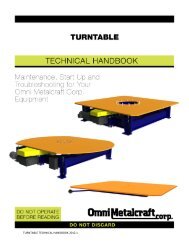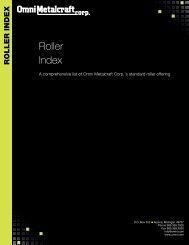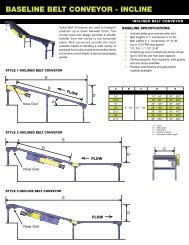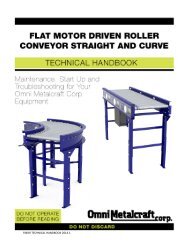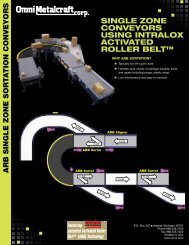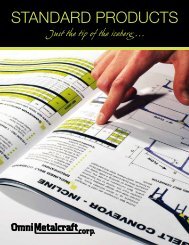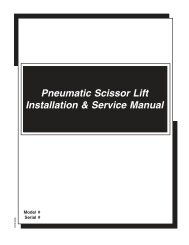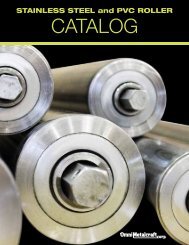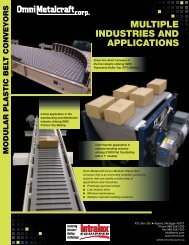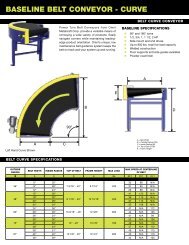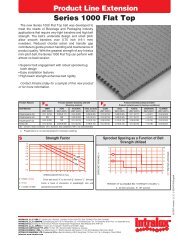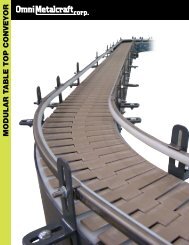Gravity Manual.pdf - Omni Metalcraft Corp.
Gravity Manual.pdf - Omni Metalcraft Corp.
Gravity Manual.pdf - Omni Metalcraft Corp.
- No tags were found...
Create successful ePaper yourself
Turn your PDF publications into a flip-book with our unique Google optimized e-Paper software.
<strong>Gravity</strong>mANUAL
SKATEWHEEL & FLOW RAILSkatewheel conveyor sections are mainly used in light duty applications and can be used in both permanentand portable applications. Skatewheel conveyor generally come as straight, curve or spur sections. Whenmultiple skatewheels are mounted into a conveyor, the independent rotation of each wheel allows the productbeing conveyed to hold its’ orientation around curves. Based on the product being conveyed, the skatewheelpattern can be modified to best suit the application.Flow rail sections are mainly used in light duty permanent racking applications. Multiple sections will bemounted in the same direction to support and convey the product.Common Skatewheel Options:• Galvanized• 1-15/16" Diameter• For 1/4" Diameter Axle• OiledOther Common Options Include:Wheel Types• Multi-Directional• Small & large diameters• High capacityCovers• Urethane• NeopreneWheel Materials• Galvanized• Aluminum• Nylon• Stainless SteelLubrication• Oiled• Greased• Dry
BALL TRANSFER TABLESBall transfer tables are mainly used as workstations or transition points where multi-directional movement isnecessary. Based on the product being conveyed, ball tables and their ball pattern can be designed to handlelight to heavy duty applications. As with all other gravity conveyors, ball transfer tables can come in bothbolted or welded construction, depending on the application.Common Ball Transfer Options:• 1" Dia. Steel Main Ball• Zinc Plated Housing• Stud MountedOther Common Options Include:Ball Transfer Types• Drop-in mount• Flange mount• Small and large diameters• 50 to 1325 lb. capacityBall Housing Material• Zinc Plated• Stainless Steel• Black Oxide FinishMain Ball Materials• Carbon Steel• Nylon• Stainless SteelLubrication• Sealed and oiled• DrySelf-Cleaning HolesLess Then Ideal Products:• “Picture Frame” bottom• Cardboard and soft bottom• Protrusions on bottom surface• Narrow bottom runners
ACCESSORIESSupportsTripod Stands - Used as a portable conveyor support mainly for skatewheeland light roller conveyorLeg Supports - Used as permanently attached conveyor support• Welded or bolted construction• “H”-Style or IndependentKnee Braces - Used with leg supports to stabilize support structurePortable Castered Legs - Permanently attached leg support for a portable conveyorMulti-Tier Supports - Permanent leg support for multiple conveyor levelsCeiling Hangers - Used as a permanent conveyor support for high elevationsTripod StandPortable Castered Legs with Knee Braces“H” - Style Leg Supports
ACCESSORIESFlow ControlFixed End Stops – Permanent mounted product stopBlade Stops – Blade can rise and lower between rollersto stop and release product• <strong>Manual</strong> Operated• Pneumatic OperatedRoller Stops – Roller can rise above rest of the rollers tostop and release product• <strong>Manual</strong> Operated• Pneumatic OperatedRoller BrakeRoller Brakes – Mounted below rollers to raise and lockroller movement. Used to stop and release product.• <strong>Manual</strong> Operated• Pneumatic OperatedBrake Rollers – Speed controlling device mountedbelow rollers to limit product speedBrake RollerOther AccessoriesSide Guides – Mounted to conveyor side frames to guide product• Fixed• AdjustableConveyor Gates – Used to provide passageway through conveyor runs• <strong>Manual</strong> Lift• Spring Assisted Lift• Gas Spring Assisted LiftAdjustable Channel Side GuidesSpring Assisted GateGas Spring Assisted Gate
FRAME OPTIONSSide Frame StylesStructural Channel• Channel heights available from 3x4.1# to 12x20.7#• Available in Mild SteelFormed Channel• Channel heights and flanges built to specification• Common thicknesses range from 12 ga. to 1/4", others available• Most common size is 3-1/2 x 1-1/2 x 10 ga.• Available in Mild Steel, Galvanized Steel, Aluminum, Stainless SteelStructural Angle• Angle heights available up to 9"• Thicknesses range from 1/8" to 1/2"• Available in Mild SteelFormed Angle• Angle heights and flange built to specification• Common thicknesses range from 12 ga. to 1/4", others available• Available in Mild Steel, Galvanized Steel, Aluminum, Stainless SteelStructural Channel Formed Channel Structural Angle Formed AngleConstruction TypesThere are two types of construction for a gravity conveyor• “Bolt Together” or Bolted Construction (as shown)- Refers to the spreaders and end couplers (see below) being bolted to the side frames- Used mainly for light to medium duty applications• Welded Construction- Refers to the spreaders and end couplers being welded to the side frames- Used mainly for heavy duty applications and in abusive environments
FRAME OPTIONS“Bolt Together” Coupler StylesHook & Rod• For portable, quick disconnect applicationsHook & RodEnd CouplersEnd Couplers• For permanent installation applicationsBridge Plate• For permanent installation applicationsBridge PlateAesthetic Options<strong>Gravity</strong> conveyor frames are available in a wide variety of material and finish options:Materials• Galvanized• Mild Steel• Aluminum• Stainless Steel- Multiple grades and polishes availableFinishes• Wet Spray Paint- Choose from standard paint colors, choose a RAL number, or have any color matchedin a enamel paint- Any color is available in an industrial enamel for quick delivery- Hi-Temp, Epoxies, and other specialty coating available• Powder Coat- Choose from standard colors, choose a RAL number,or have any color matched in a powder coat- Color matches may require extra delivery time• Galvanealed• Chrome Plated• Unfinished- Can be shipped raw or primed only
COMMON TERMSBF (Between Frame) – The distance between the side frames of a conveyor• Commonly used for bolted roller conveyor with 1.9" dia. rollers or greater, welded roller conveyor,and ball transfer tables are sized by BF, a.k.a. BF CriticalOAW (Over All Width) – The total width of a conveyor• OAW = BF + 2 x FLANGE WIDTH• Commonly used for bolted roller conveyor with 1-3/8" dia. rollers and skatewheel conveyorsare sized by OAW, a.k.a. OAW CriticalRoller Height – The height the top of a roller is above or below the side frameFrame Height – Height of the side frameLength – The length of a conveyor from end of frame to end of frameC/C – The center-to-center distance between rollersTOR (Top Of Roller) – The height of the rollers above the floor, usually with some +/- adjustmentTOL (Top Of Leg) – The height of leg support, usually with some +/- adjustmentSupport C/C – The center-to-center distance between supports
COMMON TERMS10Degree• The amount of curve a conveyor coversIR (Inside Radius)• BF Critical Conveyors- The distance from the center of the curve to the BFof the inside rail (as shown)• OAW Critical Conveyors- The distance from the center of the curve to theflange of the inside railDegreeCenter ofCurveIRSpur Hand – The orientation of the spur in relation to the main line regardless of product flow.Either left or right hand.WPF (Wheels Per Foot) – The number of wheels per foot of a skatewheel conveyor.12"Example Pattern16 WPF
Questions TO ASK11The more information that can be gathered from the customer about the application, the better <strong>Omni</strong> canhelp provide a gravity conveyor that will meet the customer’s needs. Below are some example questionsthat might be asked of the customer in order to help gather as much information as possible. Exampleresponses and reasons for each question are below each.What is the product being conveyed?Example: Wooden pallets carrying bricksReason: Is gravity conveyor a viable option?What are the product dimensions, weight, and bottom type?Example: 48" long, 48" wide, 24" tall, 1000 lbs., (3) 4" wide runnersReason: To help determine roller, wheel, or ball type and size. To determine rolling unit spacing.How many products will be on the conveyor at once?Example: Fully loaded conveyor run, products back to backReason: To help determine frame size and leg support centers.How is the product loaded and unloaded?Example: The product is end loaded by a fork truck and unloaded from the side by a fork truckReason: To help determine frame modifications, roller options, stops and guides, etc.What are the surrounding environment conditions?Example: DustyReason: To help determine material type, roller options, construction, etc.Is the conveyor mounted to other equipment?Example: No, mounted to floorReason: To help determine mounting hole size and location considerations,leg support requirements, etc.
NOTES12



